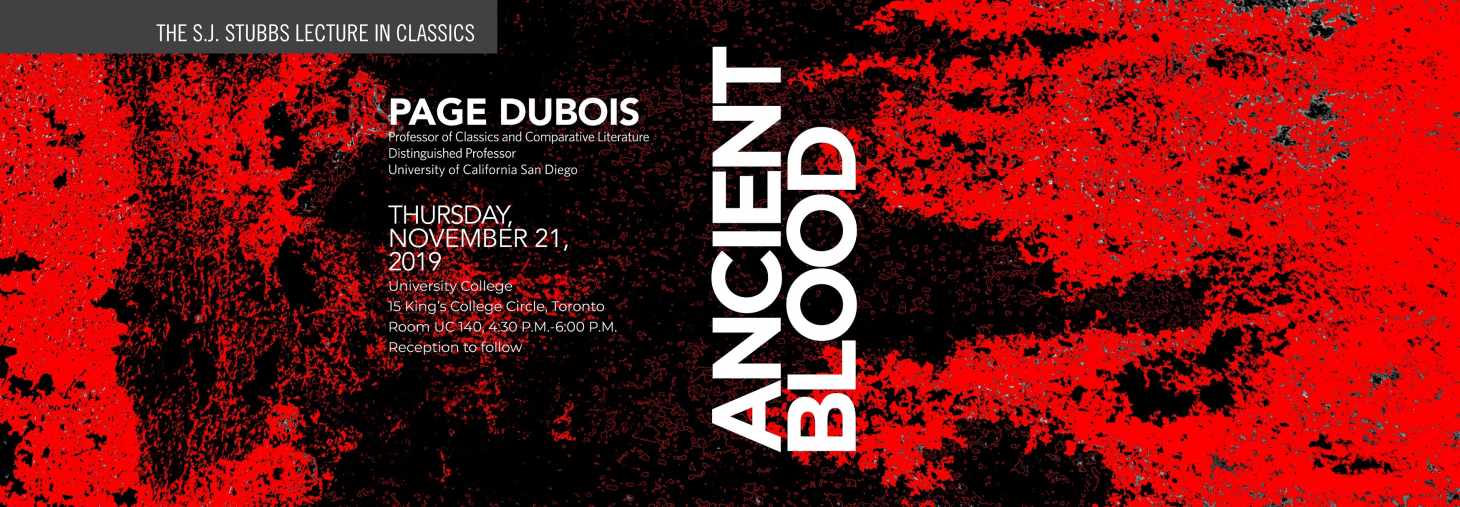
S.J. Stubbs Lecture in Classics or English Literature: Professor Page duBois, UCSD on "Ancient Blood"
Blood is a liquid that circulates in the bodies of human beings and other animals. How was it thought of in ancient culture?
In an uncanny, disturbingly aestheticizing moment in Homer’s Iliad, Menelaos husband of Helen, for whom the war is being fought before Troy, receives a wound from the arrow of his Trojan enemy Pandaros. Athena deflects the arrow, as a mother brushes away a fly from a sleeping child, but it penetrates his armor:
. . . straightway from the cut there gushed a cloud of dark blood.
As when some Maionian woman or Karian with purple (phoiniki)
colours ivory, to make it a cheek piece for horses;
it lies away in an inner room, and many a rider
longs to have it, but it is laid up to be a king’s treasure,
two things, to be the beauty of the horse, the pride of the horseman:
so, Menelaos, your shapely thighs were stained with the colour
of blood, and your legs also and the ankles beneath them.
(Iliad 4. 140-47, trans. Lattimore)
The poet-singer addresses the wounded man himself, later describes a scene of healing, and distinguishes between this blood and ikhor, the fluid flowing in the veins of the gods. The lecture will pursue questions of blood and the body; blood and the sacred; blood, belonging, and kinship, with some consideration of the applicability of these categories in the present.
Speaker Biography available here: https://literature.ucsd.edu/people/faculty/pdubois.html
Lecture: 4:30pm in UC 140
Reception to follow in UC 240
Blood is a liquid that circulates in the bodies of human beings and other animals. How was it thought of in ancient culture?
In an uncanny, disturbingly aestheticizing moment in Homer’s Iliad, Menelaos husband of Helen, for whom the war is being fought before Troy, receives a wound from the arrow of his Trojan enemy Pandaros. Athena deflects the arrow, as a mother brushes away a fly from a sleeping child, but it penetrates his armor:
. . . straightway from the cut there gushed a cloud of dark blood.
As when some Maionian woman or Karian with purple (phoiniki)
colours ivory, to make it a cheek piece for horses;
it lies away in an inner room, and many a rider
longs to have it, but it is laid up to be a king’s treasure,
two things, to be the beauty of the horse, the pride of the horseman:
so, Menelaos, your shapely thighs were stained with the colour
of blood, and your legs also and the ankles beneath them.
(Iliad 4. 140-47, trans. Lattimore)
The poet-singer addresses the wounded man himself, later describes a scene of healing, and distinguishes between this blood and ikhor, the fluid flowing in the veins of the gods. The lecture will pursue questions of blood and the body; blood and the sacred; blood, belonging, and kinship, with some consideration of the applicability of these categories in the present.
Speaker Biography available here: https://literature.ucsd.edu/people/faculty/pdubois.html
Lecture: 4:30pm in UC 140
Reception to follow in UC 240